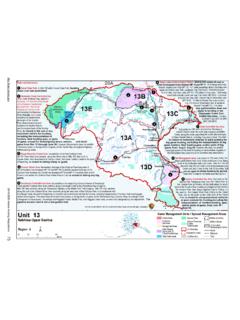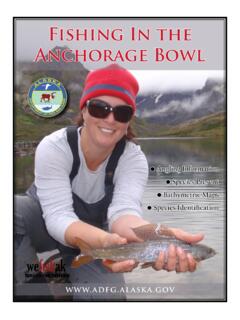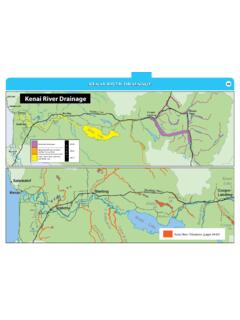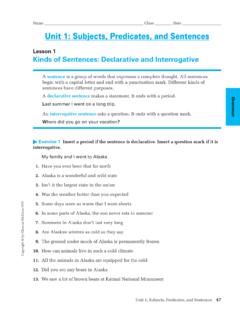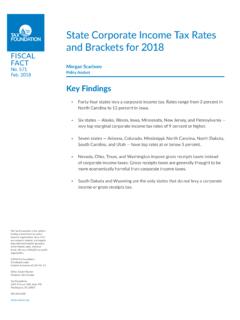Transcription of The Russian River - Alaska Department of Fish and Game
1 S o u t h c e n t r a l R e g i o n D e p a r t m e n t o f F i s h a n d G a m e Fishing the Russian River The Russian River The Russian River is a popular tributary that drains into the Kenai River . The Russian River is located 110 miles south of Anchorage, which is about a 2-3 hour drive through some of Alaska 's most spectacular roadside scenery. The River flows 12 miles from Upper Russian Lake, through Lower Russian Lake, and empties into the upper Kenai River at River Mile 74 (as measured from Cook Inlet). With its clear waters the Russian River is one of the most popular fishing destinations in Southcentral Alaska .
2 Depending on the season, anglers who fish the waters of the Russian River will find sockeye, coho, and the occasional pink salmon, and resident fish species such as rainbow trout and Dolly Varden. River . Weir counts, that are updated daily during the summer are available on the ADF&G website under Most fishing takes place in the lower three miles of fish Counts.. the Russian River and in the Kenai River from its Fishing pressure made on Russian River fisheries are confluence with the Russian River downstream about sometimes greater than the resource can provide.
3 At one mile. Certain tackle restrictions, opening dates, other times, more fish arrive than were expected. At and open and closed areas apply, so be sure to read such times, ADF&G may either close or liberalize all or the Southcentral Alaska Sport Fishing Regulation part of the fisheries by Emergency Order. During closed Summary booklet before going fishing. periods, the stocks are closely monitored by ADF&G. staff. As soon as escapement goals can be assured, the For additional information on the Russian River fishery may reopen. When more fish arrive than were fisheries, please visit the Alaska Department of fish expected, and after escapement goals are met, then the and Game webpage at Anglers fishery may be liberalized by increasing the bag and may also contact the ADF&G Soldotna office, which possession limits or season.
4 Manages this fishery, at (907) 262-9368, or call the area in-season sport fishing hotline at (907) 262-2737. Emergency Orders and their respective News Releases are available on the ADF&G weite. Select the Sport Fishery Management Fishing webpage and under Quick Links select The Russian River fisheries are managed conservatively News Releases/EOS. After posting online, the Division for sustainability by the Division of Sport fish through sends Emergency Orders to newspapers, television and management plans approved by the Alaska Board of radio stations, and other agencies.
5 Anglers may also Fisheries. To help with management, the Division subscribe to receive email notifications regarding sport maintains a fish weir at the outlet of Lower Russian fishing closures and liberalizations. Lake, about 78 miles from the mouth of the Kenai Division of Sport fish Anchor age, Al a sk a about 6 pounds, but a few grow to about 10 pounds. Most late-run salmon return to the Russian River in their fifth year of life, after spending two years in freshwater and two years in saltwater. They are a little smaller, since they have one less year of ocean growth than the early-run.
6 Run Timing The early-run usually arrives by June 15, with the historic midpoint of the run occurring on June 27. Most of the early-run fish have completed their migration by mid-July, although in some years the fish are late, or hold in the Kenai River . The early-run averages about 31,000 fish , and the Russian River Sockeye Salmon Management Plan sets the early-run escapement range River Bank Habitat & Restoration at 22,000-42,000 sockeye salmon past the weir. Anglers The banks of the River are crucial to the generally harvest about one-half of this run.
7 Long-term health of the Russian River fisheries. The second run usually arrives in mid-July and is the Trampled banks are a certain way to reduce the larger of the two runs, averaging about 61,000 fish . fish population. The management plan sets the late-run escapement Vegetation slows runoff and erosion, provides cover for range at 30,000-110,000. About 20,000 of these fish juvenile fish , cools the water, and slows the current. are harvested by anglers; however, many more are Because of the large number of people fishing the harvested by lower River anglers, personal use, and Russian River , some shoreline areas may be closed to commercial fisheries.
8 Although thousands of fish access due to rehabilitation projects. You can do your return each year to the Russian River , there may be part to preserve the Russian River for generations to considerably more or fewer fish due to egg survival come: during winter months, rearing conditions at Upper Russian Lake, ocean survival, and the size of the Respect and abide by signs that close certain commercial sockeye harvest in Cook Inlet. critical habitat areas to bank fishing. Use established trails to reach the River , and established entry and exit points.
9 Stand in the River , away from fragile vegetation. Do not place packs or other gear on the bank. Pack out what you pack in, including discarded fishing line and tackle. Do not cut brush or trees within 50 feet of the waterline. Use only the public restroom facilities provided. Sockeye Salmon Life Cycle Russian River sockeye salmon use the mainstem River as well as its tributary streams to spawn. Each female salmon lays 3,000-4,500 eggs, which hatch in late Fishing for Sockeye Salmon winter. The fry emerge from the gravel in early spring For most of the year, the Russian River is a fly-fishing- and immediately enter Upper Russian Lake.
10 Only area. A fly rod is not required, anglers may use spinning or baitcasting rods, but the hook must be a fly. Most early-run Russian River sockeye salmon spend Most Kenai River anglers use a bucktail streamer fly, two years in the Upper Russian Lake and three years at called the Russian River Coho. Other anglers say that sea before returning in their sixth year of life to spawn more sparsely-dressed flies, such as the Green Lantern, and die. The average adult early-run salmon weighs Comet, or any shrimp pattern outperform streamers. Many successful sockeye salmon patterns have enough hackle to aggravate the fish into biting.


